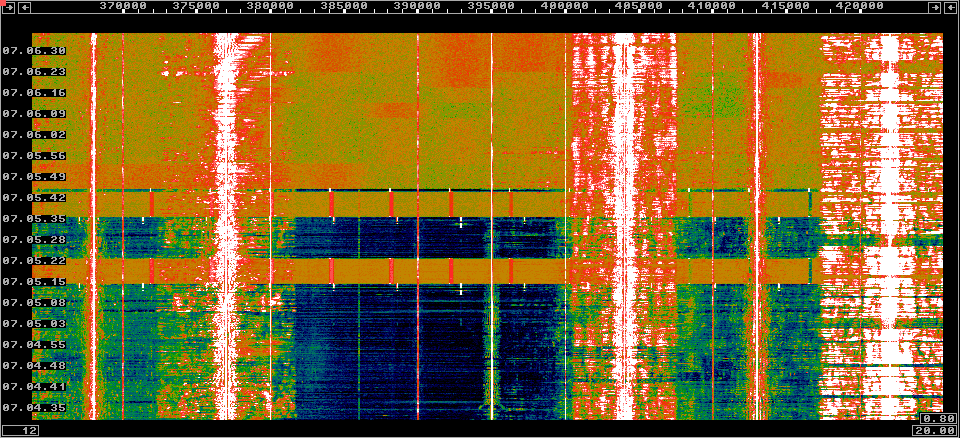
|
Figure 1 shows a one hour recording made by Mauno Ritola 0415 to 0513 UTC
on 28th January, 2009.
This was an attempt to locate the origin of the interference through
the kind cooperation of the local power company
http://www.pks.fi
They helped with an extensive series of power cuts which can be seen as
absence of interference in the figure.
Power is cut on and off at for example 06.37.05, 06.58.35,
07.01.40, 07.02.20, 07.05.30 etc.
Linrad reads local time from the .wav file recorded with Perseus.
Note that the modem has a start delay of 15 seconds.
The recording was made with a test antenna, just 20 meters of wire on the ground going to the nearest telephone pole at Mauno's house. The power was cut off in a block of flats 200 m away. Those flats are served by another branch of the phone line. Everything else on this branch of the power and telephone line, including Maunos and his nearest neighbours ADSL was switched ON, when the power was switched off in that block of flats. |

|
|
Fig. 1. A one hour recording showing the effect of power cuts
to the block of flats from where the interference originates.
The ADSL signal looks like white noise. There is no possibillity to remove ADSL interference with SDR procedures unless one has a multichannel receiver that can pick up the ADSL interferences one by one with a good S/N for each one. Then one can subtract the interferences, possibly after having decoded each ADSL signal to avoid introducing other interferences that may be present in each channel. Presumably optical fibres have made ADSL obsolete long before such technologies become available..... Figure 2 shows a 2 minute sequence from the recording in figure 1. The two minutes were obtained with the Linrad save raw file option S. The 2 minutes are from about 07.04.30 to 07.06.35 local time and since figure 2 is made with the original .raw file from Linrad, the correct timing is preserved. The .wav (zip) file you can download below does not contain time information but otherwise contains the same data. Download this file adsl-onoff.zip (46884422 bytes) and unpack the .wav file which is about 20% bigger. Use Linrad or any other SDR software to study ADSL interference. The ADSL noise first degrades the noise floor by about 15 dB, but during the last about 10 seconds of the file, the degradation is 3 dB higher. |

|
|
Fig. 2. The two minutes contained in adsl-onoff.wav.
As an example listen to Buguruslan, Orenburgskaya oblast, a 5 kW station on 1395 kHz carrying Radio Rossii. This station goes from good copy to no copy at all when ADSL starts. The file contains unprocessed loudspeaker output without AGC and thereby gives a true representation of how the interference destroys readability completely. It would be possible to set the AGC to turn down the gain when the ADSL interference starts, but as demonstrated here, with a conventional AM detector without AGC noagc.mp3 one gets the most honest demonstration. The coherent processing of Linrad can be used to improve S/N by 3 dB but that is not enough to make the signal copyable while the ADSL interference is on. SM 5 BSZ Home page Linrad home page |